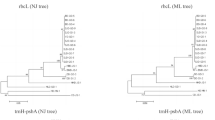Abstract
In recent years, recorded cases related to forensic botany and, in particular, of plant poisoning have become rare. We report on the medicolegal characteristics of an undetermined sudden death (USD) of a woman in which scene there were remnants of a vegetal peeling. After the autopsy, macroscopic findings reported multiorgan failure and requested the investigation of the cause of death. Postmortem blood was firstly investigated on cyanide toxicity presumptively coming from a yucca-like root; however, found cyanide levels were under normality. Because of the lack of morphological features of the encountered plant remains, a genetic nrDNA ITS2 sequence investigation was followed. The resulting DNA sequence could identify the evidence as the water dropwort (Oenanthe spp.) which contains oenanthotoxin, a potent toxin that may be fatal, similar to the more commonly found in hemlock Conium or cowbane Cicuta species. A liquid chromatography-tandem high resolution mass spectrometry (LC-QTOF MS) was later applied to analyse the vegetal extract and stomach content and successfully confirmed the toxin existence. Medicolegal and analytical findings at the forensic laboratory were described, where both biological and chemical techniques could successfully conjugate, as an interdisciplinary research, and explain premortem symptoms and postmortem findings. Present data can be helpful in future investigation on poisoning cases by conjugated polyacetylenes. The present work tries to emphasize the often undervalued plant evidence in legal medicine diagnosis in the context of an unexplained death.


Similar content being viewed by others
References
Elliot SP (2002) A case of fatal poisoning with the aconite plant: quantitative analysis in biological fluid. Sci Justice 42(2):111–115
Schep LJ, Slaughter RJ, Becket G, Beasley DMG (2009) Poisoning due to water hemlock. Clin Toxicol 47(4):270–278
Downs C, Phillips J, Ranger A, Farrell L (2002) A hemlock water dropwort curry: a case of multiple poisoning. Emerg Med J 19:472–473
Plumlee K (2004) Clin Vet.Toxicol. Mosby, Inc, St Louis Missouri, pp 337–442
Ball MJ, Flather ML, Forfar JC (1987) Hemlock water dropwort poisoning. Clin Toxicol Post Med J 63:363–365
Cho YS, Choi H, Chun BJ, Moon JM, Na J (2019) Quantitative analysis of aconitine in body fluids in a case of aconitine poisoning. Forensic Sci Med Pathol 16(2):330–334
Gómez J, Valcarce F (2003) Detected toxics in deaths related to fires and carbon monoxide poisoning. J Toxicol 20(1):38–42
White TJ, Bruns TD, Lee SB, Taylor JW (1990) Amplification and direct sequencing of fungal ribosomal RNA genes for phylogenetcis. In: PCR -Protocols and Applications -A Laboratory Manual. Academic Press p.315–322
Kite GC, Stoneham CA, Veiteh NC, Stein BK, Whitwell KE (2006) Application of liquid chromatography-mass spectrometry to the investigation of poisoning by Oenanthe crocata. J Chromatography B 838:63–70
King LA, Lewis MJ, Parry D, Twitchett PJ, Kilner EA (1985) Identification of oenanthotoxin and related compounds in hemlock water dropwort poisoning. Hum Toxicol 4(4):355–364
Furbee RB (2009) Neurotoxic plants. In: Clinical Neurotoxicology: Syndromes, Substances, Environments. Saunders Elsevier p.523–542
Anet EF, Lythgoe B, Silk MH, Trippett S (1953) Oenanthotoxin and cicutoxin. Isolation and structures. J Chem Society 0:309–322
Appendino G, Pollastro F, Verotta L, Ballero M, Romano A, Wyrembek P, Szczuraszek K, Mozrzymas JW, Taglialatela-Scafati O (2009) Polyacetylenes from Sardinian Oenanthe fistulosa: a molecular clue to risus sardonicus. J Natural Products 72(5):962–965
Li X, Yang Y, Henry R, Rosseto M et al (2015) Plant DNA barcoding: from gene to genome. Biol Rev 90:157–166
Downie SR, Plunkett GM, Watson MF, Spalik K et al (2001) Tribes and clades within Apiacea subfamily Apioideae: the contribution of molecular data. Edinburg J Bot 58:301–330
Spalik K, Downie SR, Watson MF (2009) Generic delimitations within the Sium alliance (Apiaceae tribe Oenantheae) inferred from cpDNA and rnDNA ITS sequences. Taxon 58(3):735–748
Acknowledgements
The authors would like to thank the laboratory personnel at the INTCF (Madrid) and IMELGA (Vigo) Institutions.
Code availability
Not applicable.
Author information
Authors and Affiliations
Corresponding author
Ethics declarations
This article does not contain any studies performed by the author on human participants or animals.
Conflict of interest
All authors declare that they have no conflict of interest.
Informed consent
Not applicable.
Additional information
Publisher’s note
Springer Nature remains neutral with regard to jurisdictional claims in published maps and institutional affiliations.
Key Points
1. An undetermined sudden death investigation could be determined as an accidental death when analysing the plant evidence found at the scene.
2. The barcode candidate nrDNA ITS2 was able to target the poisonous taxon and so its toxin.
3. A conjugated polyacetylene was successfully detected in the postmortem gastric content by LC-QTOF to prove the plant ingestion and explain the sudden death.
Rights and permissions
About this article
Cite this article
Martínez, P., Quintela, O., del Valle, E. et al. Genetic identification and subsequent LC-QTOF MS analysis of plant remains (Oenanthe spp.) could prove the cause of an undetermined sudden death. Int J Legal Med 135, 1407–1411 (2021). https://doi.org/10.1007/s00414-020-02488-6
Received:
Accepted:
Published:
Issue Date:
DOI: https://doi.org/10.1007/s00414-020-02488-6




